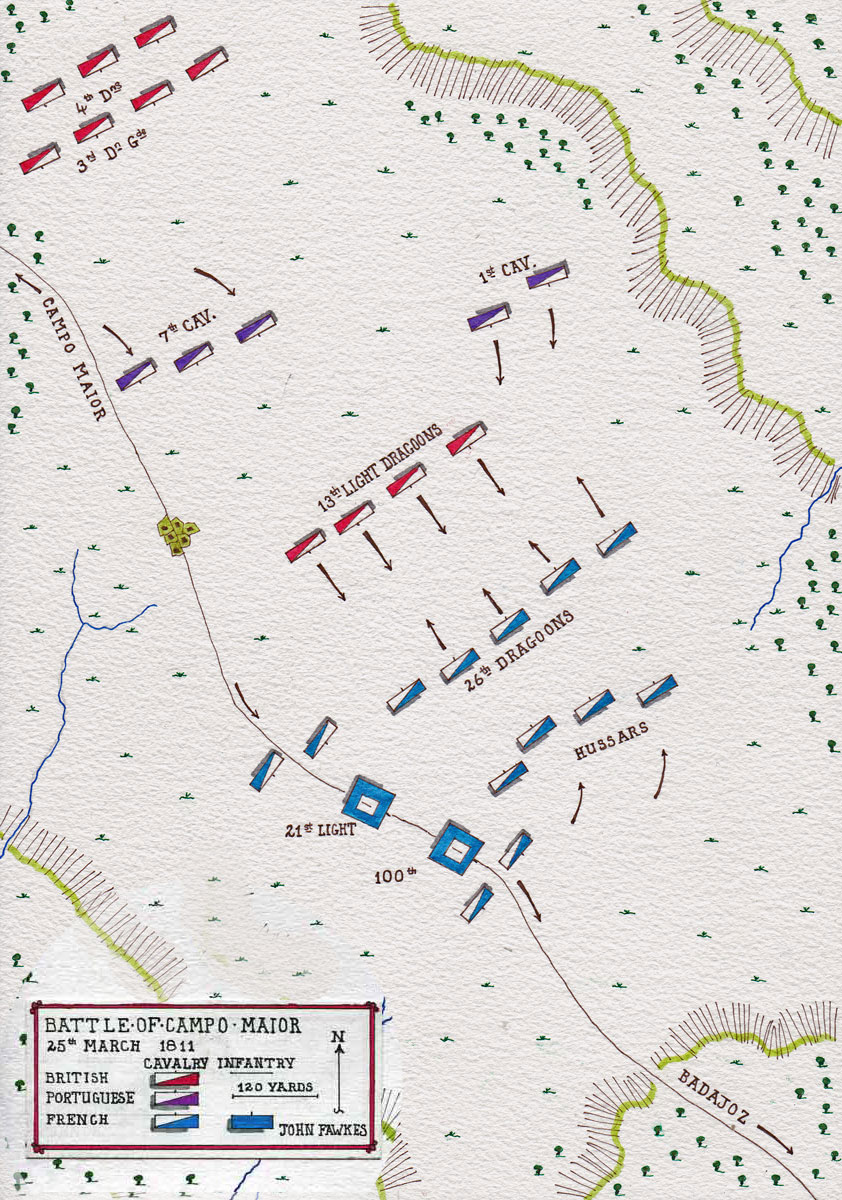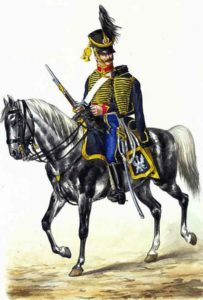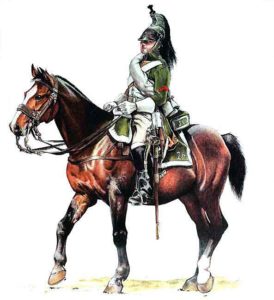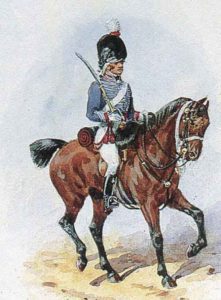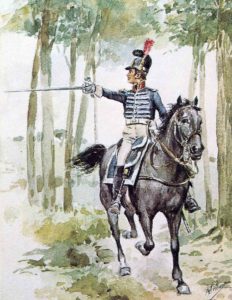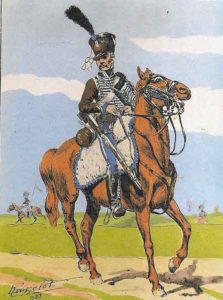The Peninsular War action fought on 25th March 1811, where the British 13th Light Dragoons overwhelmed a large force of French cavalry and captured a train of artillery
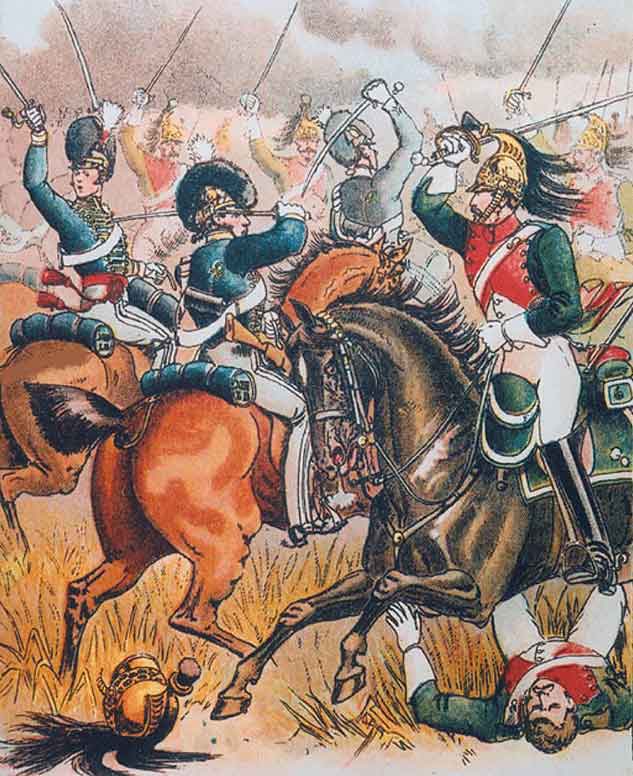
British 13th Light Dragoons charging the French 26th Dragoons at the Battle of Campo Maior on 25th March 1811 in the Peninsular War
![]() 18. Podcast of the Battle of Campo Maior: the Peninsular War action fought on 25th March 1811, where the British 13th Light Dragoons charged and swept away a larger force of French cavalry before capturing a train of artillery: John Mackenzie’s britishbattles.com Podcasts
18. Podcast of the Battle of Campo Maior: the Peninsular War action fought on 25th March 1811, where the British 13th Light Dragoons charged and swept away a larger force of French cavalry before capturing a train of artillery: John Mackenzie’s britishbattles.com Podcasts
The previous battle in the Peninsular War is the Battle of Barrosa
The next battle in the Peninsular War is the Battle of Redinha or Pombal
Battle: Campo Maior
War: Peninsular War
Date of the Battle of Campo Maior: 25th March 1811
Place of the Battle of Campo Maior: In eastern Portugal near the Spanish border on the road to Badajoz from Portalagre.
Combatants at the Battle of Campo Maior: British and Portuguese troops against a French force.
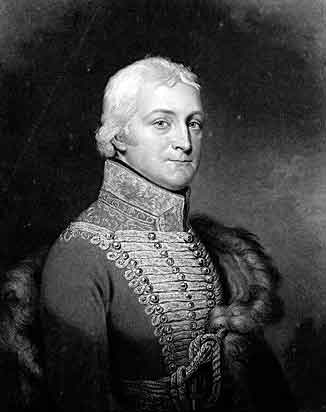
Major General Robert Long, commander of the British and Portuguese Cavalry Division at the Battle of Campo Maior on 25th March 1811 in the Peninsular War
Commanders at the Battle of Campo Maior: The British/Portuguese army was commanded by Marshal Beresford. The British cavalry commander was Major General Robert Long. The French force was commanded by General Latour Maubourg.
Size of the armies at the Battle of Campo Maior: Beresford’s British/Portuguese army comprised 3 infantry divisions and a cavalry division. The troops immediately involved in the battle were the Light Cavalry Brigade; the British 13th Light Dragoons and the 1st and 7th Portuguese Cavalry. The Heavy Cavalry Brigade comprised the 3rd Dragoon Guards and the 4th Dragoons.
The Light Cavalry Brigade, the formation immediately involved in the charge comprised under 200 men of the 13th and probably a further 300 Portuguese cavalrymen.
The French cavalry involved in the battle were the 26th Dragoons (150 men), the 2nd (350 men) and 10th Hussars (350 men), the 21st Chasseurs and the 4th Spanish Chasseurs (80 men). A French officer captured in the battle stated that there were more than 1,000 French cavalrymen present.
The French infantry comprised 1,200 men of the 100th Regiment of the Line and the 21st Light Regiment.
Uniforms, arms and equipment at the Battle of Campo Maior:
The British infantry wore red waist-length jackets, grey trousers, and stovepipe shakos. Fusilier regiments wore bearskin caps.
The Royal Artillery wore blue tunics.
British heavy cavalry (dragoon guards and dragoons) wore red jackets and ‘Roman’ style helmets with horse hair plumes.
The British light cavalry was increasingly adopting hussar uniforms, with some regiments changing their titles from ‘light dragoons’ to ‘hussars’.
At Campo Maior the 13th Light Dragoons were still in the old style light blue, Light Dragoon uniforms, with the leather peaked helmet topped by a bearskin crest.
Heath’s picture of Corporal Logan killing Count Chamorin has Logan in the shako and uniform introduced in 1812.
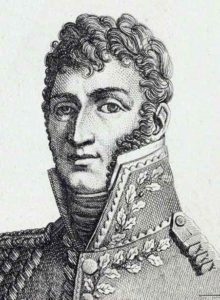
General Latour Maubourg, French commander at the Battle of Campo Maior on 25th March 1811 in the Peninsular War
The Portuguese army uniforms increasingly during the Peninsular War reflected British styles. The Portuguese line infantry wore blue uniforms, while the Caçadores light infantry regiments wore green.
The French army wore a variety of uniforms. The basic infantry uniform was dark blue.
The French cavalry comprised Cuirassiers, wearing heavy burnished metal breastplates and crested helmets, Dragoons, largely in green, Hussars, in the conventional uniform worn by this arm across Europe, and Chasseurs à Cheval, dressed as hussars.
The French foot artillery wore uniforms similar to the infantry, the horse artillery wore hussar uniforms.
The standard infantry weapon across all the armies was the muzzle-loading musket. The musket could be fired three or four times a minute, throwing a heavy ball inaccurately for a hundred metres or so. Each infantryman carried a bayonet for hand-to-hand fighting, which fitted the muzzle end of his musket.
The British rifle battalions (60th and 95th Rifles) carried the Baker rifle, a more accurate weapon but slower to fire, and a sword bayonet.
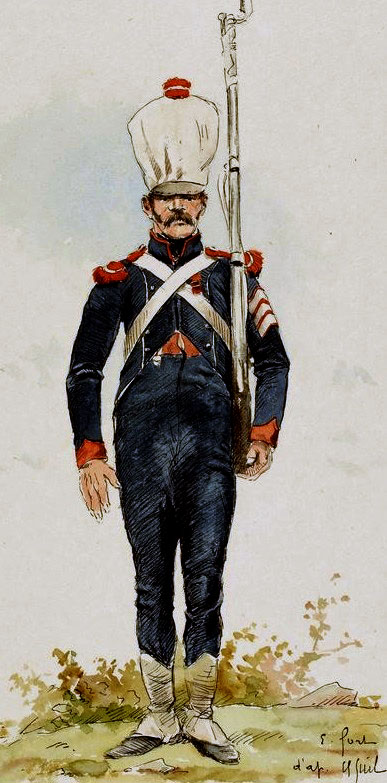
Carabinier of the French 21st Light Regiment: Battle of Campo Maior on 25th March 1811 in the Peninsular War
Field guns fired a ball projectile, of limited use against troops in the field unless those troops were closely formed. Guns also fired case shot or canister which fragmented and was highly effective against troops in the field over a short range. Exploding shells fired by howitzers, yet in their infancy. were of particular use against buildings. The British were developing shrapnel (named after the British officer who invented it) which increased the effectiveness of exploding shells against troops in the field, by exploding in the air and showering them with metal fragments.
Throughout the Peninsular War and the Waterloo campaign, the British army was plagued by a shortage of artillery. The Army was sustained by volunteer recruitment and the Royal Artillery was not able to recruit sufficient gunners for its needs.
Napoleon exploited the advances in gunnery techniques of the last years of the French Ancien Régime to create his powerful and highly mobile artillery. Many of his battles were won using a combination of the manoeuvrability and fire power of the French guns with the speed of the French columns of infantry, supported by the mass of French cavalry.
While the French conscript infantry moved about the battle field in fast moving columns, the British trained to fight in line. The Duke of Wellington reduced the number of ranks to two, to extend the line of the British infantry and to exploit fully the firepower of his regiments.
Winner of the Battle of Campo Maior:
The 13th Light Dragoons routed the French cavalry force, comprising the 26th Dragoons and Hussars from the 2nd and 10th Hussar Regiments, going on to capture the artillery train the French were taking from Campo Maior to Badajoz, but were forced to release their prisoners and abandon the captured guns. The regiment inflicted substantial casualties on the French
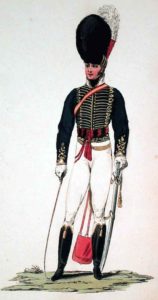
Officer of the British 13th Light Dragoons: Battle of Campo Maior on 25th March 1811 in the Peninsular War
British Regiments in action at the Battle of Campo Maior:
The only British and Portuguese regiments in action at the Battle of Campo Maior were the 13th Light Dragoons and the 1st and 7th Portuguese Cavalry.
In support, for part of the charge, were the regiments of the British Heavy Cavalry Brigade, the 3rd Dragoon Guards and the 4th Dragoons.
Background to the Battle of Campo Maior:
Over the winter of 1810-1811, Wellington held the Lines of Torres Vedras, outside Lisbon, keeping the French army of Marshal Massena at bay.
On 3rd March 1811, having suffered some 30,000 casualties from starvation and disease, Massena gave the orders for the French retreat back to the Spanish border, taking the route to the north-east.
Due east of Lisbon, the route into Spain was guarded by the fortress town of Badajoz, held by a Spanish garrison, under siege by Marshal Soult and his French army.
On 8th March 1811, Wellington ordered Marshal Beresford to march to the assistance of the Badajoz garrison, with the Second and Fourth British Divisions.
On 9th March 1811, in view of Massena’s concentration around Pombal, Beresford’s orders were cancelled.
On 11th March 1811, in spite of promising reports on the ability of the garrison in Badajoz to resist the French attack, the Spanish commander surrendered the city to Soult, who installed a strong garrison under Mortier and prepared to return to Andalusia in the south.
On 16th March 1811, Beresford resumed his advance towards the Spanish border at Badajoz.
Soult, on the 14th March 1811, marched south for Seville, where the French hold was highly precarious, following their defeat at the Battle of Barrosa.
Mortier advanced into Portugal towards the town of Campo Maior, eight miles from Badajoz.
Campo Maior is described by Fortescue as a ‘small and obsolete fortress’. The garrison was weak, but led by a determined Portuguese engineer officer, Major Talaya.
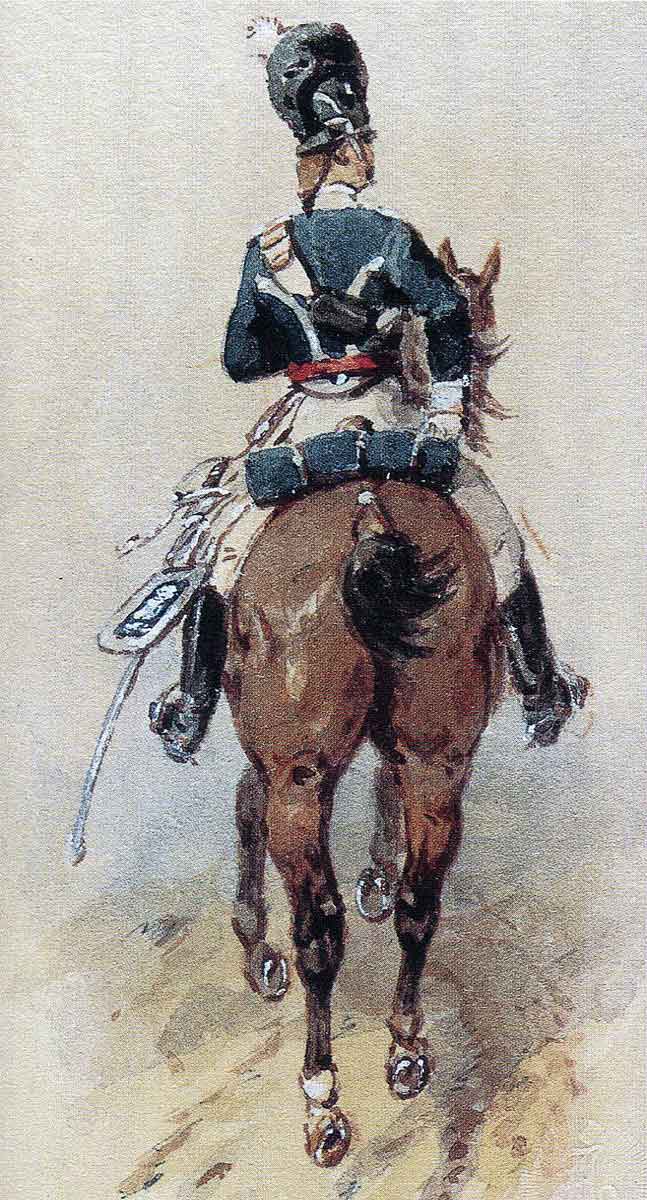
British Light Dragoon: Battle of Campo Maior on 25th March 1811 in the Peninsular War: picture by Orlando Norie
Talaya held out for 8 days against bombardment and assault, only agreeing to capitulate when it was apparent that further resistance would soon be overwhelmed.
At the same time as the assault on Campo Maior, General Latour Maubourg marched from Badajoz to attack the Spanish town of Alburquerque, to the east of Campo Maior.
The Spanish garrison of regular troops in Alburquerque promptly surrendered to the French, in sharp contrast to the Portuguese resistance in Campo Maior.
With these and other towns taken, Mortier withdrew his troops to Badajoz, leaving Latour Maubourg with 4 cavalry regiments, 1 infantry regiment and a ½ battery of light guns to dismantle the fortifications of Campo Maior and bring its guns back to Badajoz.
In the meantime, Marshal Beresford’s army was assembling at Portalegre, twenty-five miles to the north-west of Campo Maior and beginning the march down the road to Badajoz.
Beresford’s army comprised Major General Long’s Cavalry Division, the Second Infantry Division, the Fourth Infantry Division and a Portuguese Infantry Division, some 20,000 men in all.
On 23rd March 1811, Beresford received news of the French capture of Campo Maior.
On 24th March 1811, Beresford’s army marched from Arronches, halting some nine miles due west of Campo Maior.
Account of the Battle of Campo Maior:
The French general in Campo Maior, Latour Maubourg, appears to have discounted the reports from his hussar patrols of the approach of a powerful British and Portuguese army down the road from Portalegre and remained in the town for the night of 24th March 1811, taking no particular precautions.
On the morning of 25th March 1811, the French column removing the heavy guns from Campo Maior left the town for Badajoz.
Later in the morning, Beresford’s infantry crossed the Caia River and advanced on Campo Maior in two parallel columns, from the west.
Beresford, riding at the head of the cavalry division, reached a hill overlooking Campo Maior. French officers could be seen riding outside the town, apparently conducting a reconnaissance, one being General Latour Maubourg.
Seeing the approaching British and Portuguese troops, Latour Maubourg realised that he was in a tight spot, rode into Campo Maior and ordered his troops to march for Badajoz immediately.
Beresford saw the French columns forming up outside Campo Maior.
The British and Portuguese infantry divisions still being some distance from the town, Beresford ordered General Long to take the light cavalry from his division around the town walls, keeping out of range of the French guns, to discover whether the French intended to march off to Badajoz or to defend the town.
The countryside around Campo Maior consisted of rolling hills.
Beresford thought that Long was making too wide a circuit around the town and sent a staff officer to require him to move closer and thereby save time. This and other communications from Beresford warning him not to take any risks seem to have irritated Long.
Long reached a prominence twelve hundred yards from the town, from which he saw that the French cavalry were drawn up outside the walls.
Long reported this observation to Beresford and sought his instructions.
Beresford directed Long to continue around the town and threaten the French line of retreat along the road south-east to Badajoz, while Beresford came up with the infantry divisions.
Beresford despatched the brigade of heavy cavalry, that he had retained, to support Long.
In the meantime, the French General Latour Maubourg ordered his troops to march off down the Badajoz road away from Campo Maior.
Once informed of the French move, Beresford ordered Long to confront the French troops to bring them to a halt and keep them until the British and Portuguese infantry came up.
Long encountered the French column in a valley.
The British 13th Light Dragoons were moving in ‘column of ranks by threes’, a formation from which the regiment could easily form line to the right or left.
The Portuguese dragoons, wretchedly mounted on ponies and any nag they could obtain, followed in the rear of the 13th.
A troop of the 13th Light Dragoons skirmished with parties of French cavalry on the right of the regiment.
The heavy cavalry, the 3rd Dragoon Guards and the 4th Dragoons, followed in two lines, about a quarter of a mile to Long’s right rear.
The French infantry were marching in square, as they followed the route of the Badajoz road.
The French cavalry marched in front and to the rear of the infantry, 2 half-squadrons of Hussars to the front, 2 further half-squadrons to the rear, followed by the larger force on the left flank, comprising 3 squadrons of the French 26th Dragoons in column and 3 squadrons of Hussars in line (it is not clear which of the two French Hussar regiments present at the battle provided this force, the 2nd or the 10th Hussars, or both).
Coming up with the French force, General Long formed his brigade in line, with the 2 squadrons of the British 13th Light Dragoons in the front line and 2 Portuguese squadrons, commanded by Colonel Otway, on their left, probably 250 men in all.
Long retained the remaining 3 Portuguese squadrons as a reserve.
As the British and Portuguese line approached, the French formed two lines, with the 26th Dragoons in the first line and the Hussars in the second line. The total number of French cavalry in the two lines was probably in the region of 500 men.
Once formed, the French cavalry line outflanked the 13th Light Dragoons on their left flank.
Long called to the commanding officer of the 13th Light Dragoons ‘Colonel Head, there is your enemy; attack him. The Heavy Brigade are coming up in your rear.’
The opposing cavalry forces were only 200 yards apart, when Colonel Head delivered his attack, both sides at the full gallop, the British receiving fire from the French infantry as they passed them.
The 13th Light Dragoons struck the centre and left wing of the French 26th Dragoons.
It is clear that the 13th were in closer formation and under better control. The 13th threw the French dragoons back onto the French second line of Hussars and broke through both French regiments.
The 13th re-formed and charged back through the French cavalry and, in spite of an attempted attack by the unengaged right wing of the 26th Dragoons, re-formed again and charged into the disordered mass of French troopers.
The 13th delivered a third charge and swept the French cavalry force away, pursuing them at the gallop over the brow of the hill and out of sight of the onlooking infantry, both French and British.
150 men from the 13th Light Dragoons defeated some 500 men of the 26th Dragoons and the French Hussars.
The action was watched by the British Heavy Brigade and its commander, Colonel Dalbiac and the advance infantry brigade of Colonel Colborne.
For some reason, General Long did not see the outcome of the charge. However, he sent forward Otway’s 2 Portuguese troops to support Head’s 13th.
Baron Tripp, a Dutch officer on Long’s staff, rode back to the Heavy Brigade and informed them that the 13th had been overwhelmed in the cavalry fight and were all either casualties or prisoners.
Beresford, hearing of Tripp’s report and acting on the assumption that the 13th was lost, ordered the Heavy Brigade to take up position in line with its left flank on the Badajoz road, behind the French infantry, which clearly were to be permitted to continue on down the road without interference.
If had previously been Beresford’s intention to bring the French infantry to action and capture them with his overwhelmingly stronger infantry force (3 divisions against 1 French infantry regiment).
2 guns from Cleeve’s battery of King’s German Legion artillery came up and, after firing rounds at the French infantry, made to follow them, only to be ordered to halt by Beresford.
The French infantry continued on their way to Badajoz, followed, but not impeded by the British Heavy Brigade on one rear flank and the remaining Portuguese cavalry on the other.
Meanwhile, the 13th Light Dragoons, rallied and joined by Otway’s 2 Portuguese troops, were pushing on after the defeated French cavalry, which was wholly dispersed, capturing many of them.
The Portuguese troopers seized the opportunity to exchange their nags for French troop horses.
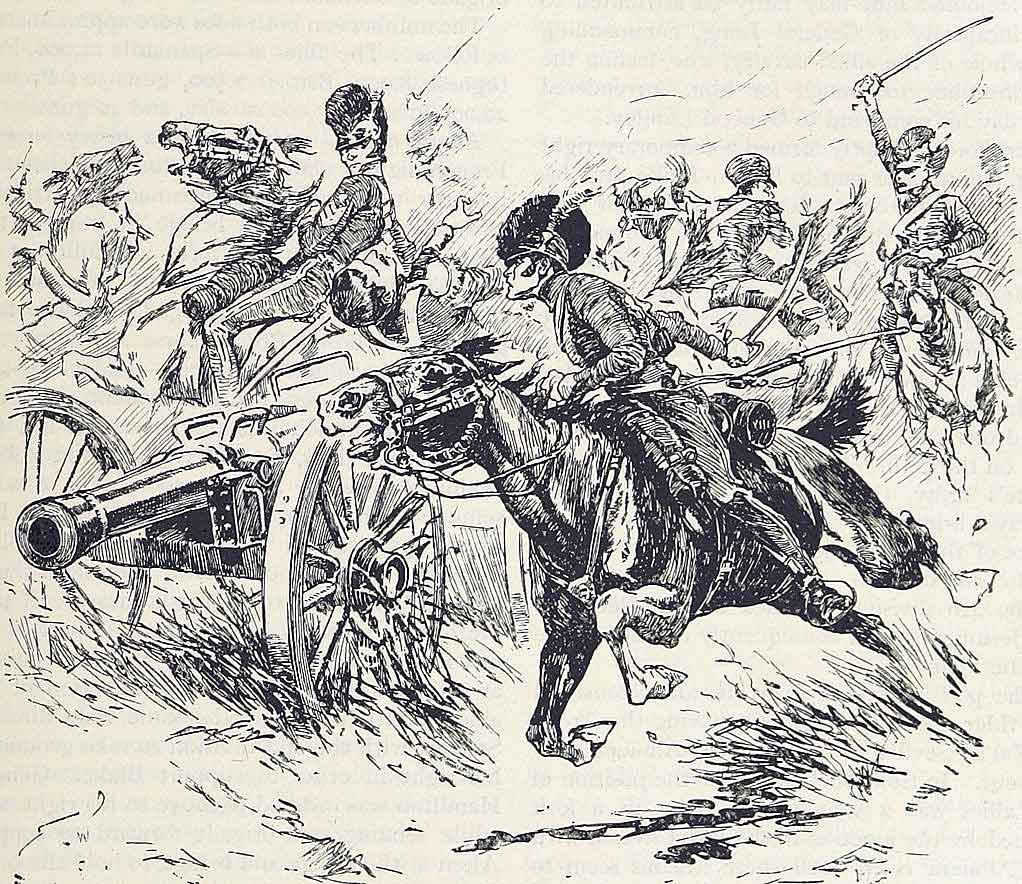
British 13th Light Dragoons capturing the French artillery at the Battle of Campo Maior on 25th March 1811 in the Peninsular War
Further on down the Badajoz road, Head’s men encountered the rear of the French train that had marched for Badajoz early in the morning with the 16 heavy guns.
Each gun and waggon was overtaken and captured, with its crews of French gunners and waggon drivers.
The final waggons and guns were pursued right up to the bridge into Badajoz, where one trooper of the 13th was taken prisoner.
The drivers of the column were replaced with British or Portuguese troopers and the 13th began the march back to Campo Maior.
The achievement of the 13th Light Dragoons was remarkable. They had overwhelmed a French cavalry force probably three times their size and captured 16 guns and many French soldiers.
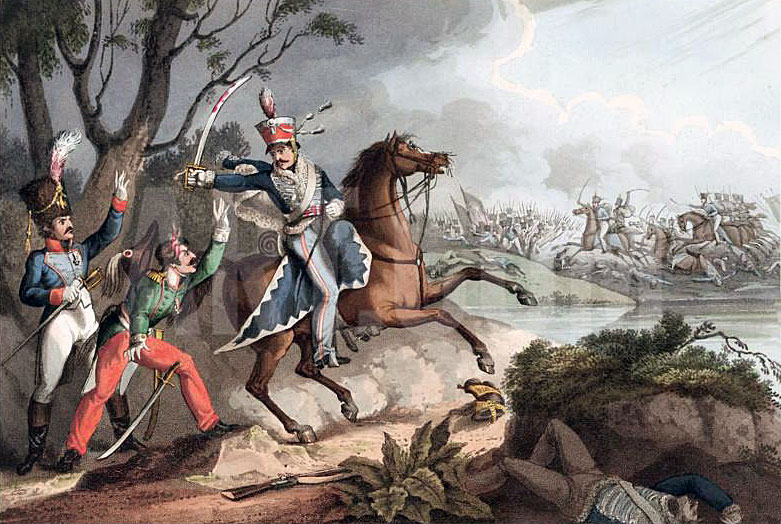
Capture of 2 French cavalry officers at the Battle of Campo Maior on 25th March 1811 in the Peninsular War: picture by William Heath
The French 26th Dragoon Regiment was a wreck, as was one of the French Hussar regiments.
As Colonel Head led his column of British and Portuguese cavalrymen and captured French guns, wagons and soldiers back up the 8 miles of road from Badajoz to Campo Maior, he was met by a trooper, followed by a second trooper sent by his wounded adjutant, informing him that the French infantry and the rest of the French Hussars were marching down the Badajoz road towards him.
Head was compelled to abandon the captured guns, wagons and French troops and ride off to the north, reaching Campo Maior by a cross-country route.
The French Hussars appeared on Head’s left flank but did not attempt to interfere with his withdrawal.
After a short ride, Head and the 13th Light Dragoons, with Otway’s Portuguese Cavalry, reached Beresford’s camp outside Campo Maior.
Casualties at the Battle of Campo Maior:
The casualties of the 13th Light Dragoons in the battle were: 10 men killed, 3 officers and 24 men wounded and 22 men taken prisoner by the French.
The 1st Portuguese Cavalry suffered 1 officer and 10 soldiers killed, 32 soldiers wounded and 27 soldiers missing.
The 7th Portuguese Cavalry suffered 3 soldiers killed, 3 soldiers wounded and 28 soldiers missing.
The British 3rd Dragoon Guards had 3 soldiers wounded.
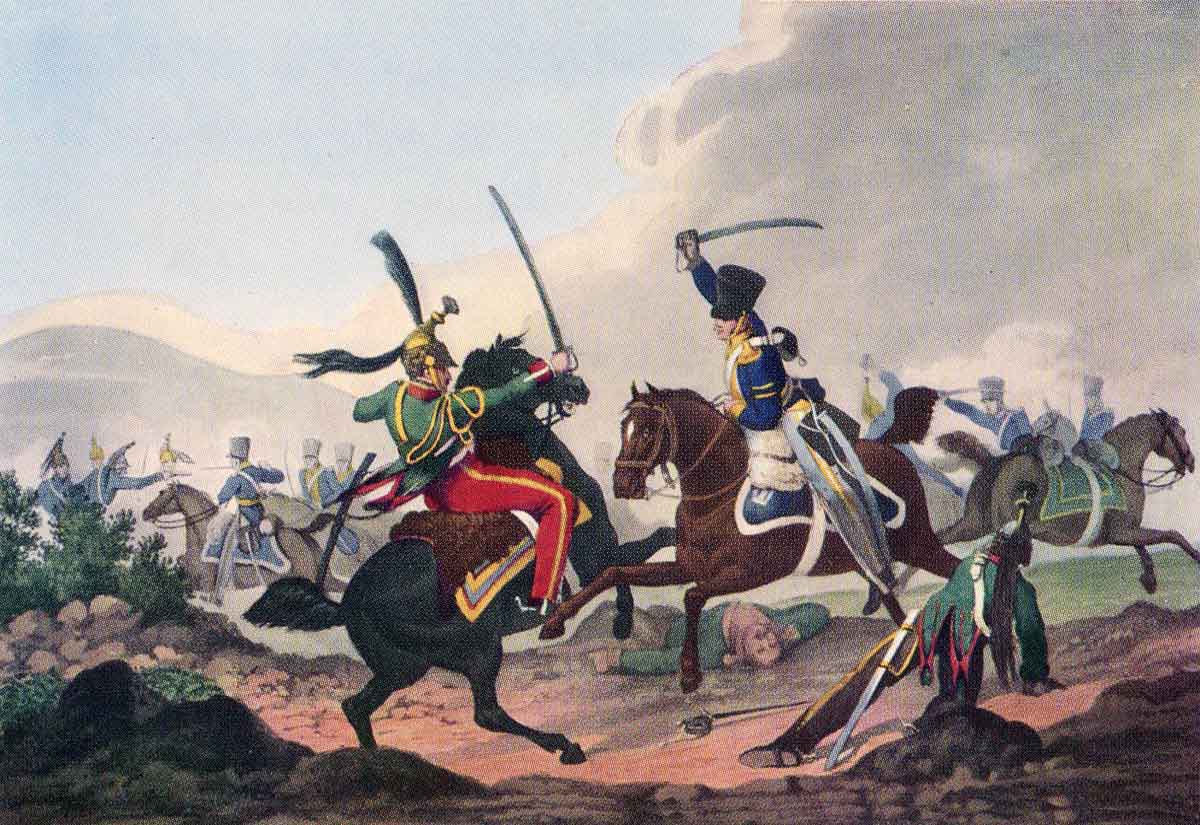
Corporal Logan engaging Count Chamorin at the Battle of Campo Maior on 25th March 1811 in the Peninsular War: the picture portrays Logan in the uniform introduced in 1812
Of the French regimental casualties, it is only possible to give the figure for the 26th Dragoons. The colonel of the 26th, Count Chamorin was killed in single combat by Corporal Logan of the 13th Light Dragoons. The 26th Dragoons suffered a further 7 officers and more than 100 men killed, wounded or captured.
In total, the French admitted to around 200 casualties. Head and Otway estimated French casualties at 800.
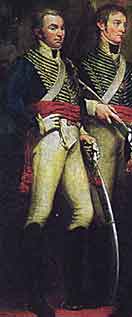
Lieutenant Colonel Michael Head, commanding the 13th Light Dragoons at the Battle of Campo Maior on 25th March 1811 in the Peninsular War
Follow-up to the Battle of Campo Maior:
Following the Battle of Campo Maior, Beresford complained to Wellington about the conduct of Colonel Head and the 13th Light Dragoons, passing on Long’s accusation that ‘the 13th had become an uncontrollable mob after their charge’.
Wellington later issued a letter severely rebuking the 13th, saying ‘their conduct was that of a rabble, galloping as fast as their horses could carry them over a plain after an enemy to which they could do no more mischief as they were broken…. If the Thirteenth Dragoons are again guilty of this conduct I shall take their horses from them, and send the officers and men to do duty at Lisbon.’
Long, who by then knew the full story of the regiment’s capture of the French column and guns, while bound to read Wellington’s letter to the 13th, stated: ‘I cannot find words to express my admiration of your gallantry on that occasion; your discipline was most conspicuous’.
Both Wellington and Beresford later, informally, acknowledged that they had misjudged the conduct of the 13th Light Dragoons at Campo Maior.
In his ‘History of the War in the Peninsular’, Sir Charles Napier severely criticised Beresford for his conduct at the Battle of Campo Maior, saying ‘The errors of the day were all Beresford’s; yet when the falsehood of Trip’s report was discovered, the thirteenth dragoons were severely reprimanded for pursuing so eagerly! But the unsparing admiration of the whole army consoled them.’
Beresford responded to Napier’s criticism with a pamphlet and an acrimonious dispute followed.
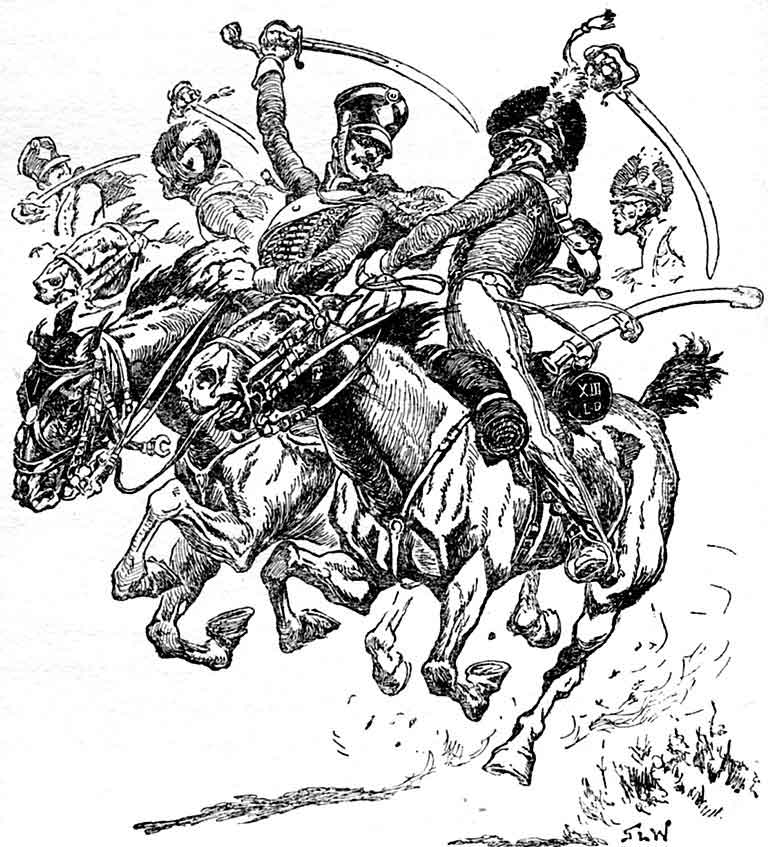
British 13th Light Dragoons in combat with French Hussars at Los Santos on 16th April 1811 in the Peninsular War: picture by Stanley Wood
Following the Battle of Campo Maior, Beresford’s army crossed the Guadiana River, took Olivenza and advanced in a south-easterly direction.
Beresford’s army halted at Zafra on 16th April 1811, where a report was received that the French cavalry were at Los Santos, blocking the road to Seville.
General Long took the British and Portuguese Cavalry Division to engage the French cavalry, who were drawn up in a narrow roadway flanked on each side by stone walls.
The Light Brigade, headed by the British 13th Light Dragoons, were ordered forward to engage the French cavalry, while the Heavy Brigade rode around the French flank.
The French retired and, on being pressed, turned and galloped off, pursued by the 13th Light Dragoons.
The pursuit was over 9 miles almost to the town of Usagre.
The 13th Light Dragoons found that the French regiments were the ones that had been so roughly handled at the Battle of Campo Maior and brought back 150 French prisoners, with trifling loss to themselves.
This time Beresford commended the 13th Light Dragoons whole heartedly.
Battle Honours:
The Battle of Campo Maior is not a British battle honour and is not a clasp on the General Service Medal.
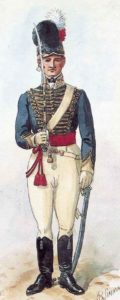
Officer of British 13th Light Dragoons: Battle of Campo Maior on 25th March 1811 in the Peninsular War
Anecdotes and traditions from the Battle of Campo Maior:
- Corporal Logan of the 13th Light Dragoons was engaged by Count Chamorin, colonel of the French 26th Dragoons, during the combat between the regiments at the Battle of Campo Maior. Logan, a powerful swordsman, cut Chamorin across the face, knocking off his helmet. Logan then brought his sword down on Chamorin’s head, cleaving his skull and killing him. Logan collected Chamorin’s helmet and sword as trophies. After the battle Logan sold the helmet to the 13th’s paymaster and presented the sword to Colonel Head, his commanding officer. The French General Latour Maubourg sent a flag of truce to Beresford after the battle, to enquire into the fate of Count Chamorin.
References for the Battle of Campo Maior:
See the extensive list of references given at the end of the Peninsular War Index.
The previous battle in the Peninsular War is the Battle of Barrosa
The next battle in the Peninsular War is the Battle of Redinha or Pombal
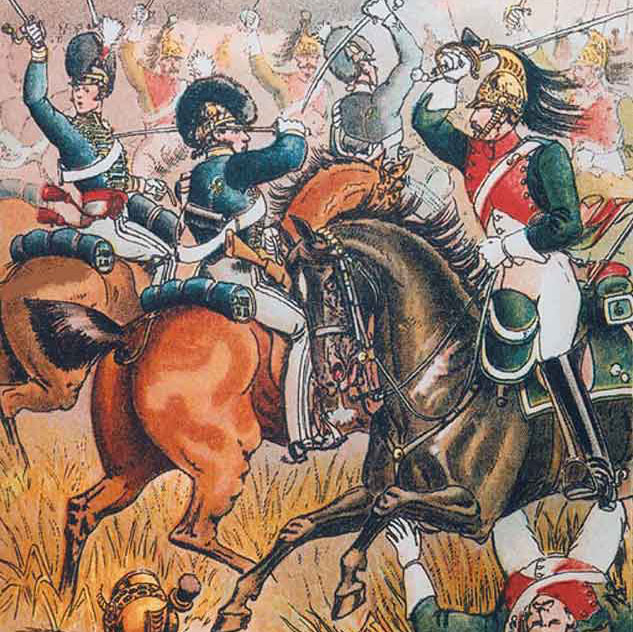 18. Podcast of the Battle of Campo Maior: the Peninsular War action fought on 25th March 1811, where the British 13th Light Dragoons charged and swept away a larger force of French cavalry before capturing a train of artillery: John Mackenzie’s britishbattles.com Podcasts
18. Podcast of the Battle of Campo Maior: the Peninsular War action fought on 25th March 1811, where the British 13th Light Dragoons charged and swept away a larger force of French cavalry before capturing a train of artillery: John Mackenzie’s britishbattles.com Podcasts
